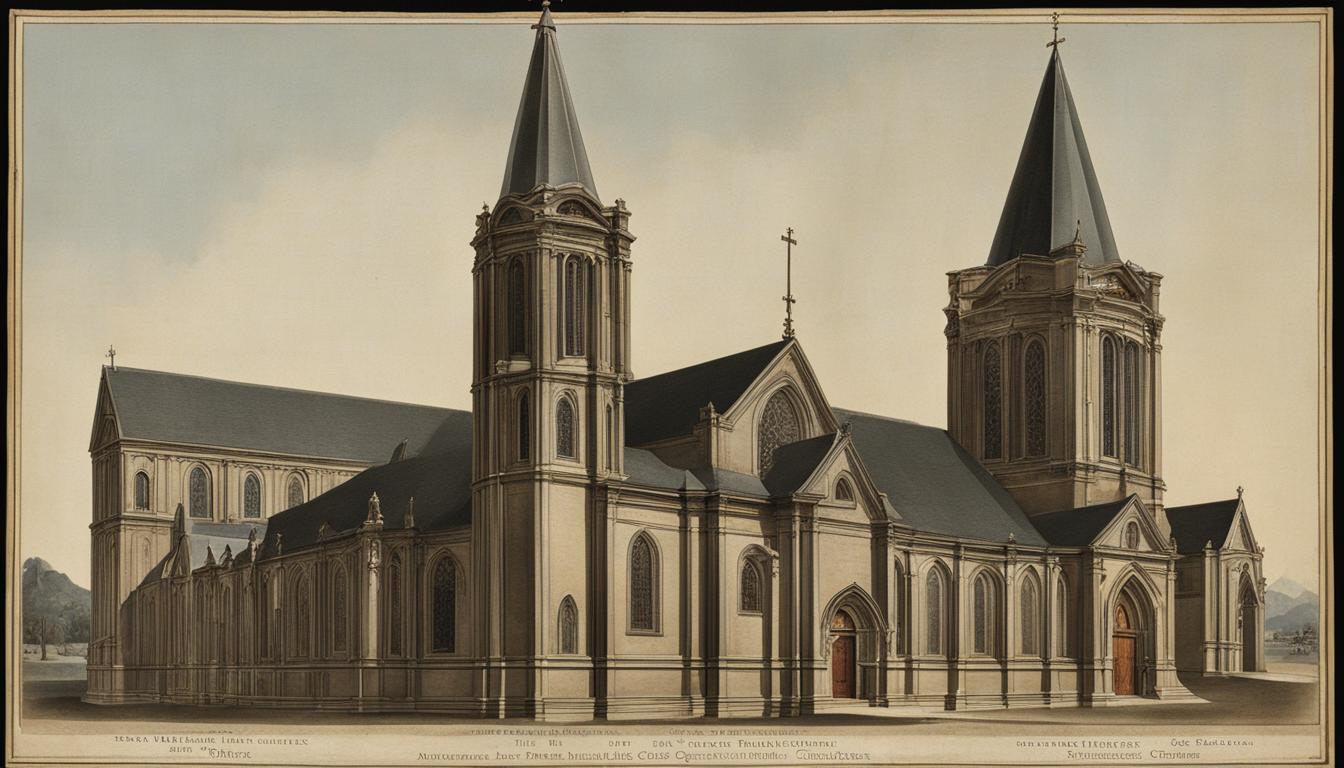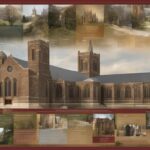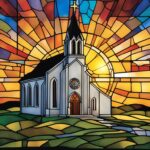The Seventh-day Adventist Church has a rich and fascinating history that dates back to the early 1800s in the United States. What began as a small group of individuals seeking to study and rediscover biblical truths quickly grew into a global movement that now boasts a membership of over 20 million believers.
During the Second Great Awakening, a period of religious revivalism, many Christians became inspired to delve deeper into the teachings of the Bible. Among them were individuals who began to embrace the importance of observing the seventh-day Sabbath and the belief in the imminent Second Coming of Christ.
One key figure in the early development of the Adventist movement was William Miller, a preacher who predicted that the Second Coming would occur between 1843 and 1844. Although his prediction did not come to pass, a group of devoted believers continued to study the Bible and seek deeper understanding.
It was during this time that the foundations of the Seventh-day Adventist Church were laid. Through the leadership of figures like Ellen G. White, who played a significant role in shaping Adventist theology and practice, the movement grew and spread across the United States and eventually around the world.
Today, the Seventh-day Adventist Church remains committed to its historical roots and continues to be a vibrant and influential force in global Christianity.
Key Takeaways:
- The Seventh-day Adventist Church originated in the early 1800s during the Second Great Awakening in the United States.
- Believers in the Adventist movement focused on studying the Bible and rediscovering biblical truths like the seventh-day Sabbath and the Second Coming of Christ.
- The movement gained momentum through the teachings of William Miller, despite his prediction of the Second Coming not materializing.
- The foundations of the Seventh-day Adventist Church were laid by a small group of dedicated believers who continued to study the Bible.
- Leaders like Ellen G. White played a significant role in shaping Adventist theology and practice.
Beliefs and Doctrines of the Seventh-day Adventist Church
The Seventh-day Adventist Church holds a unique set of beliefs and doctrines that set it apart from other Christian denominations. These beliefs are rooted in the study of biblical prophecy and are guided by the writings of Ellen G. White, one of the early leaders of the church.
One of the key beliefs of the Seventh-day Adventist Church is the imminent second coming of Jesus Christ. Adventists believe that Jesus will return to Earth in the near future to establish His kingdom and bring an end to sin and suffering.
Another important belief is the observance of the seventh-day Sabbath as a day of rest and worship. Adventists regard the Sabbath, from Friday evening to Saturday evening, as a sacred time to connect with God, spend time with loved ones, and engage in acts of service and benevolence.
The concept of conditional immortality is also central to Adventist doctrine. This belief holds that the dead sleep until the resurrection, rather than experiencing immediate and eternal afterlife. Adventists believe in the ultimate resurrection and judgment, where the righteous will attain eternal life, while the wicked will face eternal annihilation.
The Seventh-day Adventist Church also emphasizes the mediatorial ministry of Jesus in the heavenly sanctuary. This belief teaches that Jesus is currently interceding for humanity, mediating between God and humanity, and cleansing the heavenly sanctuary from sin.
Additionally, the Adventist Church believes in the existence of a remnant church called to proclaim the third angel’s message of Revelation 14. This message emphasizes the importance of keeping God’s commandments, including the observance of the Sabbath, and calls for the worship of the Creator rather than the beast/mankind.
“We have nothing to fear for the future, except as we shall forget the way the Lord has led us, and His teaching in our past history.” – Ellen G. White
Sacraments and Rituals in the Seventh-day Adventist Church
The Seventh-day Adventist Church recognizes two sacraments that hold great significance in the spiritual life of its members. These sacraments, baptism and the Lord’s Supper, are deeply rooted in the teachings and beliefs of the Adventist faith.
Baptism: A Symbol of New Life in Christ
Baptism is a sacred ritual in the Seventh-day Adventist Church and is viewed as a symbol of new life in Christ. It represents a profound commitment to follow Jesus and embrace His teachings. Adventists practice baptism by full immersion, symbolizing the washing away of sins and emerging as a new creation in Christ.
Through baptism, individuals publicly declare their faith and acceptance of Jesus as their Savior and Lord. It signifies a turning point in their spiritual journey and marks the beginning of a lifelong commitment to follow Christ’s example.
The Lord’s Supper: Commemorating the Sacrifice of Jesus Christ
The Lord’s Supper, also known as communion, is a cherished ritual observed in the Seventh-day Adventist Church. It is a solemn and reverent ceremony that commemorates the sacrifice of Jesus Christ on the cross for the redemption of humanity.
During the Lord’s Supper, Adventist believers partake of unleavened bread and unfermented grape juice, which symbolize the body and blood of Jesus. Through this act, believers remember the immense love and sacrifice of Christ, expressing gratitude for His grace and forgiveness.
The Adventist Church typically observes the Lord’s Supper on a quarterly basis, fostering a sense of anticipation and reflection as members gather to participate in this deeply meaningful ritual.
Personal Spiritual Growth and Daily Devotional Practices
In addition to the sacraments, the Seventh-day Adventist Church places great emphasis on personal spiritual growth and daily devotional practices as essential rituals for spiritual nourishment.
Adventists believe in the transformative power of prayer and encourage regular communion with God through heartfelt conversations and expressions of gratitude, supplication, and worship. They recognize prayer as a means of seeking divine guidance, finding strength, and cultivating a deeper relationship with God.
Another central ritual in Adventist practice is Bible study. Adventists believe that the Bible is the inspired Word of God and turn to its teachings for spiritual guidance and enlightenment. The study of Scripture is seen as an opportunity for personal growth, biblical understanding, and deepening one’s faith.

Through the observance of sacraments and the practice of spiritual rituals, the Seventh-day Adventist Church seeks to nurture the faith of its members and strengthen their connection to God. These sacred practices serve as reminders of God’s love, grace, and the eternal hope found in Jesus Christ.
Leadership and Clergy in the Seventh-day Adventist Church
The Seventh-day Adventist Church operates with a well-defined hierarchical structure that ensures effective leadership at every level. At the apex of this structure is the General Conference, the highest governing body responsible for overseeing the global operations of the church. Underneath the General Conference, there are various administrative divisions and unions that further serve to coordinate and facilitate the mission and ministry of the church.
Within local churches, the leadership is entrusted to dedicated pastors who play a crucial role in providing spiritual guidance and nurturing the congregation. These pastors are responsible for preaching sermons, conducting worship services, administering sacraments, and offering pastoral care to church members. They are often supported by a team of dedicated individuals serving as elders and deacons, who assist in the overall spiritual leadership of the congregation.

Significantly, the Seventh-day Adventist Church recognizes and affirms the ministry of women. In recent years, there has been a growing acceptance and appointment of female pastors within the church. These women bring valuable perspectives and skills to the pastoral role, enriching the leadership landscape of the Adventist Church.
“Leadership should not be about power or authority but about service and humility. It is through genuine servant leadership that we can best reflect the character of Christ and effectively minister to God’s people.”
The leaders within the Seventh-day Adventist Church are expected to exemplify the principles of servant leadership, guided by Jesus’ teachings on humility and selflessness. They are called to shepherd the flock with love and compassion, inspiring and equipping individuals to grow spiritually and engage in active service within the church and the larger community.
Worship Practices in the Seventh-day Adventist Church
Worship in the Seventh-day Adventist Church is a transformative experience that revolves around the reverence for God, the focus on biblical truth, and the emphasis on practical Christian living. The church follows a rich tradition of worship practices that engage the congregation in meaningful ways, fostering a deep connection with God and fellow believers.
Congregational Singing
In the Seventh-day Adventist Church, congregational singing holds a special place in worship. Hymns and spiritual songs are sung by the entire congregation, creating a unified voice of praise and adoration. Music not only uplifts the soul but also reinforces biblical truths, inspiring worshipers to draw closer to God.
Prayer and Scripture Reading
Prayer is a fundamental element of Adventist worship. It is a time when believers commune with God, seeking His guidance, expressing gratitude, and presenting their needs. Scripture reading, accompanied by thoughtful reflection and meditation, forms the cornerstone of Adventist worship. Through the reading and hearing of God’s Word, worshipers are enlightened, inspired, and challenged in their faith walk.
Preaching and Proclamation
The proclamation of the Word of God is a central aspect of Adventist worship services. Trained ministers or pastors deliver insightful and uplifting sermons that explore biblical truths and their practical application to everyday life. These sermons aim to encourage spiritual growth, inspire personal transformation, and foster a deeper relationship with God.
Testimonies and Spiritual Sharing
Adventist worship often includes a time for personal testimonies and the sharing of spiritual experiences. This allows members to express gratitude, share blessings, and encourage one another through personal stories of God’s faithfulness. Testimonies serve as a reminder of God’s presence and work in the lives of individuals and the church as a whole, inspiring others in their own faith journey.
“Worship is not about mere rituals; it is about the intimate connection with God and the faith community.”

Reverence and Devotion
Adventist worship emphasizes the importance of reverence and devotion. Believers approach God with awe and humility, recognizing His holiness and their dependence on His grace. The worship environment is designed to create a sacred space where individuals can focus their hearts and minds on God, free from distractions.
In addition to these core practices, Adventists also engage in various other worship activities such as the celebration of special events and holidays, participation in communal rituals like foot washing, and the observance of other spiritual disciplines like fasting and confession. Overall, Adventist worship seeks to engage believers holistically, nurturing their spiritual growth and fostering a deeper connection with God and fellow believers.
Sacred Texts of the Seventh-day Adventist Church
The Seventh-day Adventist Church considers the Bible to be its primary sacred text, encompassing both the Old and New Testaments. This foundational belief stems from their unwavering faith in the divine inspiration and authority of the Scriptures. Adventists regard the Bible as the ultimate source of truth and guidance for their faith and practice, shaping their worldview and fostering spiritual growth.

In addition to the Bible, the writings of Ellen G. White, a highly esteemed figure within the Seventh-day Adventist Church, hold significant value. Ellen G. White is regarded as a modern-day prophetess, and her teachings are considered an essential complement to the biblical text. Her writings provide additional insights into biblical truth and spiritual guidance, offering Adventists a deeper understanding of their faith and principles.
“The Bible is the inspired and trustworthy Word of God, revealing the divine will and purpose for humanity.” – Seventh-day Adventist Fundamental Beliefs
Denominations and Sects within the Seventh-day Adventist Church
The Seventh-day Adventist Church, with its worldwide membership of over 20 million, is a distinct denomination within Christianity. However, within the larger Adventist movement, there are also various sects and independent groups that have different interpretations of certain doctrines or practices.
Some of these groups align closely with the traditional teachings and practices of the Adventist Church, while others have diverged and formed their own distinct beliefs and practices. These denominations and sects within the Seventh-day Adventist Church contribute to the rich tapestry of diversity and theological exploration within the broader Adventist community.

Denominations within the Seventh-day Adventist Church
Denominations within the Seventh-day Adventist Church represent various groups that have developed their unique identities while still maintaining a connection to the broader Adventist faith. These denominations often have specific beliefs, practices, or organizational structures that set them apart.
One example of such a denomination is the Advent Christian Church, which emerged in the mid-19th century. This denomination shares many beliefs in common with the Seventh-day Adventist Church but also has its theological distinctives.
| Denomination | Founding Year | Main Beliefs |
|---|---|---|
| Advent Christian Church | 1860 | Conditional immortality, annihilationism |
| Seventh Day Adventist Reform Movement | 1925 | Emphasis on the original teachings of Ellen G. White |
| Church of God (Seventh Day) | 1863 | Observance of the seventh-day Sabbath |
Independent Sects within the Seventh-day Adventist Church
Independent sects within the Seventh-day Adventist Church are typically smaller groups that have chosen to separate from the larger organization and form their independent communities.
These sects may have different interpretations of Adventist doctrines or may emphasize specific aspects of Adventist teachings in unique ways.
“We believe in the imminent second coming of Jesus Christ and strive to live in anticipation of His glorious return” – Independent Adventist sect leader
One example of an independent sect is the Remnant Church, which emerged in the late 20th century. This group follows a strict interpretation of Adventist beliefs and practices and places a particular emphasis on the remnant church teachings found in the book of Revelation.
The Importance of Denominations and Sects
These denominations and sects within the Seventh-day Adventist Church offer various perspectives that contribute to the ongoing theological dialogue and exploration within the Adventist community. While they may differ in certain beliefs or practices, they are united by a common heritage and a desire to serve God faithfully.
These diverse expressions of faith reflect the richness and vibrancy of the Seventh-day Adventist Church and provide opportunities for individuals to find a spiritual home that resonates with their unique beliefs and convictions.
Community and Outreach in the Seventh-day Adventist Church
The Seventh-day Adventist Church is deeply committed to fostering a sense of community and engaging in impactful outreach initiatives. Our members are encouraged to actively participate in their local communities, sharing the love and compassion of Christ through various avenues.
Through our dedicated community service projects, we strive to make a positive difference in the lives of individuals and communities. From organizing food drives and clothing donations to providing assistance to the homeless and underprivileged, we are passionate about meeting the practical needs of those around us.
In addition, Adventist churches regularly host health clinics, serving as a valuable resource for promoting wellness and providing access to healthcare services. These clinics offer free medical screenings, consultations, and education on healthy living practices to empower individuals to take charge of their well-being.
Recognizing the pivotal role of education in transforming lives, the Seventh-day Adventist Church operates a vast network of schools worldwide. Our educational institutions strive to instill values, provide quality education, and equip students with the necessary skills to make a positive impact in their communities and beyond.
Disaster relief efforts are another crucial aspect of our outreach. When disaster strikes, the Seventh-day Adventist Church mobilizes its resources and volunteers to provide aid and support to affected communities. From providing emergency supplies and shelter to offering emotional and spiritual care, we stand ready to serve those in need.
Furthermore, the church operates various publishing houses that produce literature promoting spiritual growth and offering guidance on various aspects of life. These publications serve as valuable resources for individuals and communities seeking spiritual nourishment and personal development.
In summary, the Seventh-day Adventist Church is committed to making a tangible difference in the world through community engagement and outreach. Whether through community service projects, health clinics, education initiatives, disaster relief efforts, or the dissemination of literature, we strive to exemplify Christ’s love and compassion in action.
Architectural and Artistic Features in Seventh-day Adventist Churches
The architectural and artistic features of Seventh-day Adventist churches reflect both cultural and regional influences, resulting in a diverse range of styles. However, a common characteristic among many Adventist churches is their emphasis on simplicity, functionality, and practicality.
Seventh-day Adventist churches are designed to create a welcoming environment that fosters spiritual growth and reflection for their congregations. The architecture focuses on creating spaces that are conducive to worship and community gathering.
One notable artistic feature often found in Adventist churches is stained glass windows. These windows depict biblical scenes and Adventist beliefs, bringing vibrant and captivating imagery into the sacred space. The vibrant colors and intricate designs of stained glass windows add to the overall aesthetic appeal of the church and serve as a source of inspiration for worshippers.
Adventist churches may also showcase other forms of artwork, such as paintings or sculptures, that depict biblical narratives or symbols of faith. These artistic elements contribute to the visual storytelling within the church, providing a means for worshippers to connect with their faith on a deeper level.
The architectural and artistic features within Seventh-day Adventist churches serve as a testament to the significance of visual aesthetics in religious expression. They not only enhance the physical space but also create an atmosphere of reverence, inspiration, and contemplation for worshippers.
Contemporary Issues and Challenges for the Seventh-day Adventist Church
Like any religious denomination, the Seventh-day Adventist Church faces various contemporary issues and challenges. In today’s rapidly changing world, one of the primary challenges is adapting to technological advancements and digital media. The church must find innovative ways to utilize technology to reach out to a wider audience and engage with the younger generation who are increasingly reliant on digital platforms for information and communication.
Another significant challenge is addressing evolving cultural and societal norms. As societal values and attitudes shift, the church must navigate the delicate balance between adhering to its traditional beliefs and doctrines while also remaining relevant and open to dialogue with the wider community. This requires careful consideration and discernment to ensure that the church’s teachings and practices are grounded in biblical principles while still resonating with contemporary audiences.
Fostering inclusivity and diversity within the church is another priority. The Seventh-day Adventist Church strives to be a welcoming and inclusive community, embracing individuals from different backgrounds, cultures, and walks of life. This includes ongoing efforts to promote gender equality and diversity in leadership roles, as well as addressing issues related to LGBTQ+ rights and the experiences of marginalized groups. The church recognizes the importance of creating an environment where everyone feels valued, loved, and accepted.
Furthermore, the Adventist Church grapples with debates on topics such as the ordination of women, LGBTQ+ rights, and the role of science in relation to religious beliefs. These discussions require thoughtful and respectful dialogue to ensure that the church remains faithful to its core principles while engaging with diverse perspectives and seeking unity within its diverse membership. Navigating these complex issues requires a commitment to diligent study, prayerful discernment, and a genuine desire for understanding and unity within the church.
FAQ
What is the history of the Seventh-day Adventist Church?
The Seventh-day Adventist Church traces its origins back to the Second Great Awakening in the United States during the early 1800s. It was during this time that several groups of devout Christians, inspired by the revivalist movement, began studying the Bible and rediscovering biblical truths such as the seventh-day Sabbath and the literal Second Coming of Christ.
What are the beliefs and doctrines of the Seventh-day Adventist Church?
Some of the key beliefs include the imminent second coming of Jesus Christ, the observance of the seventh-day Sabbath as a day of rest and worship, the concept of conditional immortality (the belief that the dead sleep until the resurrection), the mediatorial ministry of Jesus in the heavenly sanctuary, and the existence of a remnant church called to proclaim the third angel’s message of Revelation 14.
What sacraments and rituals are practiced in the Seventh-day Adventist Church?
The Seventh-day Adventist Church recognizes two sacraments: baptism and the Lord’s Supper. Baptism is seen as a symbol of new life in Christ and is typically administered by full immersion. The Lord’s Supper, also known as communion, is a commemoration of the sacrifice of Jesus Christ and is typically observed quarterly.
Who are the leaders and clergy in the Seventh-day Adventist Church?
The Seventh-day Adventist Church has a hierarchical organizational structure with leadership positions at multiple levels. The highest level of leadership is the General Conference, which oversees the global operations of the church. At the local level, each church is led by a pastor who is responsible for preaching, teaching, and pastoral care. The Adventist Church also recognizes the ministry of women and has female pastors serving in various capacities.
What are the worship practices in the Seventh-day Adventist Church?
Worship in the Seventh-day Adventist Church typically includes elements such as congregational singing, prayer, Scripture reading, and preaching. The church places a strong emphasis on the study of the Bible and the proclamation of the Word. Worship services often include a time for personal testimonies and the sharing of spiritual experiences.
What are the sacred texts of the Seventh-day Adventist Church?
The primary sacred text of the Seventh-day Adventist Church is the Bible, encompassing both the Old and New Testaments. Adventists believe in the divine inspiration and authority of the Bible and consider it to be the ultimate source of truth and guidance for their faith and practice. In addition to the Bible, the writings of Ellen G. White, who is considered a modern-day prophetess, are also highly regarded within the Adventist Church.
Are there denominations and sects within the Seventh-day Adventist Church?
Yes, there are various sects and independent groups within the larger Adventist movement that may have differing interpretations of certain doctrines or practices.
How does the Seventh-day Adventist Church engage in community and outreach?
The Seventh-day Adventist Church places a strong emphasis on community and outreach. Members are encouraged to be actively involved in their local communities, promoting health, education, and social services. Adventist churches often engage in community service projects, health clinics, education programs, disaster relief efforts, and other initiatives aimed at improving the quality of life for individuals and communities.
What are the architectural and artistic features in Seventh-day Adventist churches?
Architectural styles within the Seventh-day Adventist Church vary depending on cultural and regional influences. However, many Adventist churches feature simple and functional designs that prioritize functionality and practicality. The focus is often on creating a space conducive to worship and community gathering. Some churches may incorporate stained glass windows or artwork depicting biblical scenes or Adventist beliefs.
What are the contemporary issues and challenges for the Seventh-day Adventist Church?
Like any religious denomination, the Seventh-day Adventist Church faces various contemporary issues and challenges. Some of these include adapting to technological advancements and digital media, addressing evolving cultural and societal norms, balancing traditional beliefs with changing theological perspectives, and fostering inclusivity and diversity within the church.
















